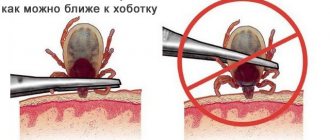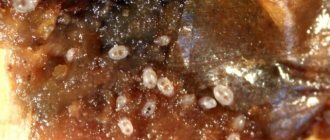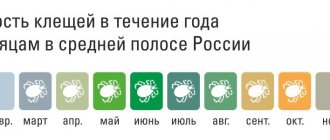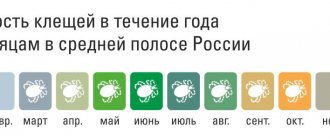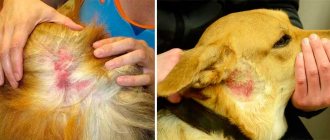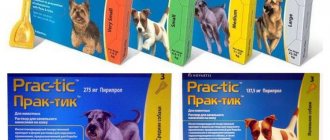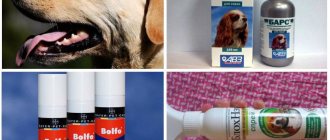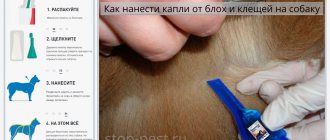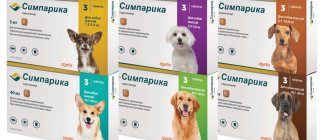How to treat a dog for ticks
In the last 2-3 years, experts have noted an increase in the population and an increase in the activity of various types of ticks. This is due to an increase in average annual temperature and, as a consequence, warmer winters. As a result, ticks do not fall into a state of suspended animation, or “sleep” during the shortest coldest period. Thus, the duration of their activity period increases every year. This means that pet owners need to remember this threat and promptly provide protection from very dangerous insects. Know how to treat a tick bite on a dog.
The most dangerous period is still spring. The time for ticks to awaken and actively reproduce and patiently search for food.
Important tips if your dog is bitten by a tick
- Even if you left part of a tick in the wound, do not panic. He can no longer inject saliva. But inflammation may begin, so it is better to contact a veterinarian so that he can remove the remains of the parasite.
- A tick can sit on a dog’s fur for 2–3 hours before it attaches itself to the skin. This is why inspections after every walk are so important.
- Even if the tick you tested turned out to be infectious, this does not mean that the dog will definitely get sick. In some animals, the immune system copes with infection on its own.
- Ticks are talked about a lot in the summer, but they become active from the end of March. And they don’t disappear until the first frost. During this period, treatment should be constant: write down the dates when the tablets were given, the collar was put on for the first time, check the timing of all medications.
- Some diseases are dangerous for both dogs and people. For example, borreliosis. Therefore, treating your pet is important for the health of your entire family.
Consequences of a tick attack on a dog
In addition to the fact that the tick bite itself is quite unpleasant, it can lead to a number of consequences:
- The immediate moment of the bite remains invisible to the “owner”, thanks to the tick injecting an anticoagulant and anesthetic substance contained in the tick’s saliva into the wound. After detaching the tick, a wound remains that can become inflamed and itchy.
- There are many types of ticks in nature. Some species parasitize dogs, causing diseases such as otodectosis (ear mites) and sarcoptic mange (scabies). These ticks, when attacking, multiply on the dog. Thus causing extensive lesions with the formation of constantly itchy, bald, inflamed areas on the skin.
- Another tick that is dangerous from a veterinary and medical point of view is ixodid. Their individuals are quite large and visible to the naked eye and parasitize on the surface of the skin. The main danger of this species is that they are carriers of infectious diseases such as tick-borne encephalitis, piroplasmosis, Lyme disease and others.
IMPORTANT! Ticks carry diseases that also affect humans. Including viral encephalitis. But this disease is not relevant for dogs.
From the above, we can conclude how important it is to timely and effectively treat dogs against ticks. Currently, developers of veterinary drugs offer products that can provide protection against most of the threats and consequences that ticks pose to dogs.
An example of a complex treatment against external parasites is the drug Simparika in the form of chewable tablets. Taking Simparika will provide your dog with protection from fleas, ixodid ticks, otodectic mange, sarcoptic mange and demodectic mange, and will also significantly reduce the risk of contracting vector-borne diseases.
Ixodid ticks
This is a whole family of arthropod parasites, numbering 650 species. On the territory of Russia, the highest danger is represented by dog ticks (they infect not only animals, but also humans) and taiga ticks.
Above we have listed places where a dog can be infected with these blood-sucking parasites. They climb onto branches of bushes or trees located low to the ground, on blades of grass and wait for their prey. If a dog passes in this place, the tick will jump or simply fall on it.
These arthropods are quite small. In a hungry state, their body length does not exceed 5-7 mm, and the colors can be of various shades. If you find a tick on your dog's fur, what should you do? You need to carefully remove it and kill it. If he has not yet had time to attach himself, then he does not pose any danger.
Once on the animal’s fur, the parasite strives to quickly reach its body and dig into the flesh. The tick's mouthparts are ideally suited to this. It is equipped with a dense chitinous proboscis with hooks, at the base of which there are salivary glands. The tick injects the victim with saliva containing blood anticoagulants (they prevent blood clotting) and painkillers. Therefore, the animal does not feel the bite. A tick that has drunk blood increases in size several times. Its body takes on a brownish or grayish tint.
When to treat your dog for ticks in the spring
If active ticks or the symptoms they carry with them are found on your pet in early spring, it means the treatment is late. To prevent this from happening, the main guideline should be the ambient temperature. Ticks begin actively searching for food when a stable temperature of +10°C or higher is established. However, the potential danger of attack arises already at +1°C, when the insects wake up. It is recommended to take care of protecting the animal from this moment on.
Sarcoptoid mite
It is often confused with scabies because it also causes scabies. The routes of infection and symptoms of infection with these two types of parasites are identical. The animal itches a lot and injures the skin with its claws. In these places, pustules form, inflammation, and dandruff appears. Without treatment, bald spots appear on the body of an infected animal, and exudative dermatitis may occur.
The pet begins to weaken, its protective properties of the body decrease.
To carry out diagnostics to detect the parasite, scrapings are taken.
Owners are interested in what inexpensive anti-tick medications are available for dogs. If your pet is diagnosed with sarcoptic mange, bathing with tar soap is recommended. This option is the most economical, but quite effective. You can also use antiseborrheic shampoos, for example Oxymed, Animall Vetline, Veterinary Formula.
Means and methods of protection
There are several methods for preventing tick attacks practiced by owners. The simplest measures include:
- Wearing special clothing is a mechanical way to prevent ticks from attacking your dog. If the dog is accustomed to wearing clothes, then a jumpsuit with ties around the paws can protect it from the penetration of only some individuals of Ixodid ticks. After all, ticks can stick to the area of the pads, and between the toes, on the head, on the mucous membranes of the mouth and genitals. And small individuals can easily penetrate under clothing. Therefore, this method can only be used as an additional method in combination with drugs. It is better to choose light-colored clothing - ticks are better visible. There are models equipped with special traps from which ticks cannot escape.
- Inspection and combing. Once on the coat, parasites can wander throughout the dog’s body until they reach their favorite places (eyelids, neck, ears, withers). You need to examine your pet immediately after each walk.
- The use of strong-smelling essential oils of clove, mint, wormwood, geranium, vanillin solution. Their smells should repel blood-sucking insects. But in practice this does not work well, since solutions sprayed onto wool will only act until the esters have evaporated, and this often happens before you get to the place of your walk.
Such simple folk measures do not provide any guarantees and are most likely ineffective.
A more reliable way to protect your pet is to use special medications that protect against external parasites. Let's consider: what is the best way to treat a dog against ticks. It must be remembered that these products should not only be destructive to parasites, but also not harmful to the dog’s body. Therefore, it is important to choose a means of protection responsibly and adhere to the following recommendations:
- Carefully study the instructions for the selected drug;
- Take into account the physiological state, age, clinical condition, individual characteristics of the dog;
- If it is difficult to understand all the nuances, seek advice from a veterinarian.
Remedies for external parasites can be divided into two large groups:
- internal or systemic drugs
- external or contact-acting drugs
Traditional methods of treatment
When it was not possible to protect the pet, signs of subcutaneous mites are detected, treatment is necessary. Many pets react negatively to drug therapy options, and for some breeds they are generally contraindicated. It is in such cases that folk remedies are used. They are used depending on what type of tick the dog has.
Protection against ixodid ticks
Ixodid ticks appear on your pet's body after a walk; they can be removed by bathing with tar soap or shampoo with the addition of essential oils.
If the tick is deeply ingrained into the dog’s skin, then essential oil in its pure form will help remove the parasite. The problem area is generously lubricated with one of the above oils and the parasite is removed using tweezers in a circular motion.
Washing the dog
Subcutaneous mites
These parasites can be eliminated without the use of medications. There are several options:
- An infusion of celandine roots will be irreplaceable; the washed and purified raw materials are poured with sunflower oil in a 1:1 ratio. Maintain at a temperature of 50 degrees for at least 4 hours. The strained infusion is applied to problem areas daily.
- Juniper berries and sour apples are crushed into puree, mixed well and applied to the affected areas.
- Sour cream or kefir with black sulfur also have healing properties; the ingredients are mixed well in a 3:1 ratio.
- Birch tar will cope perfectly with the problem; the product is applied directly to the affected areas daily.
According to reviews, all of the above methods are effective, but before using them you should consult a veterinarian. This will allow you to choose the most suitable treatment option and not harm the dog.
Pills
The most modern among systemic drugs and developed relatively recently are tablets of the isoxazoline group. They have become the parasite prevention choice for many veterinarians and dog owners. And they allow you to protect your pet from fleas and ticks, including ixodid ticks.
Let's consider their mechanism of action using Simparika chewable tablets as an example. Simparika tablets are an innovative development of one of the leading international manufacturers of veterinary drugs. Advanced technologies have made it possible to create a drug with a wide spectrum of action against external parasites and at the same time with good tolerance for the body of dogs.
The component sarolaner has a destructive effect on parasites. During the first three hours after taking the drug, its active substance is distributed throughout the dog’s body, protecting both the skin and mucous membranes of the animal from parasites. Contact of sarolaner with parasites causes progressive paralysis of their nervous system and, as a result, death.
The use of Simparica chewable tablets has the following benefits for protection against parasites:
- Unlike external contact agents, it is not washed off when bathing, including using shampoos.
- It is not present on the surface of skin and fur, therefore contact of humans and other pets with the active substance is excluded. There is no risk of poisoning when licking fur. This is true, for example, for cats living next to a treated dog, or for puppies living next to a nursing mother.
- Belongs to 4, the lowest hazard class
- Approved for use for nursing and pregnant dogs, as well as for puppies from 2 months of age.
- Unlike external drugs, it also protects mucous membranes.
- Flavoring additives make Simparika tablets very attractive to dogs, and the treatment process for parasites does not cause difficulties.
- The action of the drug is complex; Simparika is active against most external parasites.
Infusions
Dogs are also protected from parasites with infusions. These DIY tick repellents have been found to be no less effective than oils.
You can protect your dog from bloodsuckers with the following infusions:
- Wormwood is the main enemy of all parasites; just 20 g of fresh grass per liter of water can repel ticks and fleas from your four-legged pet. The ingredients are combined, brought to a boil, and cooled. Strain and apply with a spray bottle before each exit to the street.
- You can prepare another infusion at home; it contains vanillin and vodka. For every 2 g of dry matter, take 100 g of alcohol, mix well and keep for 10 days in a cool, dark place. Next, the mixture is poured into a container with a sprayer, treatment is carried out every day before going outside.
- You can also fight parasites with garlic water; to prepare it you will need half a liter of liquid and three cloves of garlic. Peeled and chopped garlic is placed in water and left for 8 hours, then applied to the back and withers of the animal before each walk. It is not recommended to treat other parts of the body; the dog will be able to lick itself.
Folk remedies for dogs against ticks
You can also treat your dog against ticks using combined means; essential oils are often added to infusions. Before conducting such experiments, it is necessary to consult a veterinarian; he will be able to give effective advice on combining substances.
Drops on the withers
They have a liquid base and come in the form of pipettes. The drugs are applied in drops to the dog’s skin in the withers area. The effectiveness of the drug will greatly depend on compliance with the rules of use. Contact action drops are fat-soluble and for best effect they need a lipid layer that is located on the surface of the animal’s skin. Thus, before applying the drops, the dog should not be bathed for at least 2 days before and for 2-3 days after treatment - since the drops must be absorbed and distributed in the lipid layer. Such preparations should be applied strictly to the skin, spreading the fur in places inaccessible for licking (withers).
Due to long-term distribution over the surface of the lipid layer, the effect of the drops reaches its maximum 2-3 days after application. Therefore, you should not expect a quick acaricidal effect immediately after applying the drug - you must wait 24-48 hours for activation. After applying the drops, you need to limit your pet’s contact with children and other animals until the drug is completely absorbed. Information about this is usually specified in the instructions.
Ear mites
These parasites can only be seen with a microscope, since their sizes are extremely small (up to 0.5 mm). They parasitize in the ears of animals, but in some cases they can migrate to the head. The disease is caused by otodectosis.
Dogs become infected with this mite from other animals, as well as through grooming items (combs, beds). Even the owner can bring the parasite into the house on shoes or clothes.
How to detect ear mites on a dog? Signs appear only 2 weeks after infection. The arthropod gnaws passages in the ears, in which it lays eggs. The parasite also pierces the victim's skin to extract lymph and blood. All this causes the dog to itch. She begins to scratch her ears and scratch them with her claws. Some animals press their heads to the floor and sit in this position.
Another important sign is dark crusts in the ears. They are a mixture of sulfur and parasite excrement.
If the animal is not treated, it may die. The fact is that the parasite eventually gnaws through the eardrum. As a result, pus enters the inner ear and then onto the lining of the brain. A less sad outcome is the animal’s deafness.
How to get rid of ear mites in dogs? Treatment is carried out by external means. These are drops, ointments, sprays. The animal's ears must be treated with the preparations according to the attached instructions.
Veterinarians often prescribe Bars for ear mites in dogs. In reviews, owners write that the product acts quite quickly. After the first use, the pet stops intensively scratching its ears. However, the treatment must be carried out for a long time (at least a month).
Among the shortcomings of the product, the owners point out its too unpleasant smell and not entirely harmless composition. Bars ear drops contain diazinon, which is a toxic substance. In addition, in some reviews, pet owners note that the product caused allergic reactions in their pets, which then had to be treated.
Other drugs used in the treatment of otodectosis:
- "Surolan";
- "Oricin";
- "Otoferonol Gold".
If the disease is advanced, the dog is given injections. Preparations:
- "Ivomek";
- "Aversect-2";
- "Cydectin".
Sprays
The spectrum of activity against parasites, the speed of action and the principle of operation depend on the active substance included in the composition. But all sprays are external preparations. The disadvantages include the complexity of the dosage, and, as a rule, a short period of action. As well as a decrease in efficiency upon contact with water
It is better to apply sprays outdoors - this will save both the owner and the pet from inhaling an extra portion of active substances.
Demodexes
They are called hair mites because they parasitize hair follicles. Causes the disease demodicosis. Hair mites are very small. One bulb can house a whole colony of them.
These parasites are considered conditionally pathogenic, since they do not manifest themselves as long as the animal has a sufficiently high immunity. If the dog is weakened, for example after illness or surgery, the tick develops vigorous activity, causing hair loss. The disease can appear in one area of the skin or throughout the animal's entire body.
Canine demodicosis does not spread to humans. Rottweilers, dachshunds, German shepherds, collies, and boxers are most susceptible to it.
Ointments “Yam” and “Parmethrin” are used for treatment. These remedies are considered the best if the disease is localized in certain areas of the dog’s body. In the generalized form, doctors prescribe tablets “Ivermectin”, “Milbemax”, as well as drops “Advocate”, “Advantis” and others.
Ticks are very dangerous blood-sucking parasites. Dog owners should carefully examine their pets after each walk, take preventive measures, and if the animal becomes infected, begin treatment on time.
What is the best way to treat your dog for ticks?
A veterinarian familiar with the individual characteristics of your dog will advise you on the best remedy that is right for you. However, the above information about the mechanism of action, the pros and cons of the proposed drugs will allow you to make the choice of a suitable remedy yourself.
When choosing one drug or another, it is important to remember that any drug has limitations and features of use, so before using it, it is important to carefully read the instructions. And even the most effective remedy cannot provide a 100% guarantee and does not negate careful attention to the pet and its condition. Examine your dog after a walk, pay attention to changes in behavior and the appearance of nonspecific symptoms. This will allow you to make a timely decision to contact a veterinary clinic.
Apple Cider Vinegar Is Deadly to Ticks in Dogs
Apple cider vinegar is another home remedy that ticks hate. Apple cider vinegar is composed of acetic acid and is also responsible for the bitter element and becomes a mite remover .
To perform this home remedy, you only need to mix water and vinegar in equal parts, dampen the mixture with a clean cloth or cotton, and gently and very gently wet your dog's skin, avoiding the eye area.
How to treat a dog after a tick bite
What to do if you did not treat your dog for parasites in time and found a tick attached to it?
- Remove the parasite: put on gloves, then hold the body with tweezers at the very surface of the skin or use a special twister to twist the tick out of the wound with a rotational motion.
- Treat the bite site. How to treat a dog's wound after a tick? – any antiseptic (70% alcohol, brilliant green, alcohol solution of iodine) that is in your first aid kit.
- Contact a veterinary clinic. If you were able to remove the tick, submit it for analysis. The doctor will check the dog's blood for infection with piroplasmosis and babesiosis. These are express tests with quick results. If a positive result is obtained, the pet will be prescribed therapy.
- Monitor the dog even after receiving a negative result for 2-3 weeks. Fever, lethargy, and refusal to feed should alert you.
What to do if your dog is bitten by a tick
Some diseases do not develop immediately, but are chronic in nature.
For example, piroplasmosis, anaplasmosis and Lyme disease. Their symptoms may appear after some time, when it is too late to treat the dog. Therefore, you need to remove ticks from your skin immediately after a walk. What to do if your dog is bitten by a tick:
- Using special tweezers, remove the tick from the skin, being careful not to damage it. Ideally, the parasite should be removed by a veterinarian. But if you can’t urgently take your dog to the clinic, you’ll have to master this art yourself. Below we will give detailed instructions on how to do this correctly.
- Submit the tick to a laboratory for analysis to ensure that it is not a carrier of dangerous infections. The parasite must be placed in a clean and sealed plastic bag. It is better to find out the addresses of the clinics in advance: not every veterinary laboratory does such an analysis.
- Monitor your dog’s well-being closely for 2–3 weeks.
Find a veterinarian
Most often, ticks “settle” in secluded places: on the face, in the armpits, on the stomach and in the genital area. A newly attached tick looks like a small black spider. When the parasite drinks blood, it looks like a large black-brown pea. Take a good look at the potential mite - it could be a mole or papilloma.
Dogs at risk include:
- with short hair - Chihuahuas, Rottweilers
- with a thin undercoat - Yorkshire terriers
- hunting dogs that spend a lot of time in the forest
It is also not easy to spot ticks in thick fur, so owners of huskies, Samoyeds, Spitz dogs and other owners of luxurious fur coats must use anti-tick medications. But the presence of such treatment in no way frees you from daily inspection.
What you should never do:
- Lubricate the tick with oil
in the hope that it will suffocate. In fact, the parasite will only dig deeper into the skin and inject saliva containing harmful microorganisms into the animal’s body. - Douse the tick with alcohol
, kerosene or vodka. Yes, these remedies will help kill the parasite - it will literally “tear it apart.” But at the same time, harmful substances from his digestive system will get onto the dog’s skin. - Squeeze the parasite
with your hands, pull it out with your nails, or use tweezers. If you damage the body or leave the head of the tick in the wound, your dog may become infected.
How to properly treat your dog for ticks
It is important not only to choose the right means of protection, but also to apply it correctly. Let's list the main points:
- Strictly follow the dosage indicated in the instructions. It depends on the weight of the animal and must be necessary and sufficient. Simparic tablets are convenient to dose: they are available in six different dosages for dogs weighing from 1.3 kg to 60 kg.
- Apply the next portion of protection on time. Please take into account the expiration date of the product. For example, for drops on the withers this is an average of 2-3 days. And Simparic tablets are maximally active after 12 hours.
- Follow the manufacturer's recommendations specified in the instructions. Studying the instructions is boring, but very important. And it will help to avoid unwanted consequences from taking this or that drug.
TOP 5 best anti-tick tablets for dogs
Currently, the most popular and effective drugs are:
- "Bravecto"
- "Inspector Quadro Tabs"
- "Simparica"
- "Frontline Nexgard"
- "Nexgard Spectra"
1) Anti-tick tablets “Bravecto”/ “Bravecto”
Anti-tick tablets for dogs “Bravecto”/ “Bravecto”
| / "Bravecto" | Intervet GesmbH (MSD Animal Health), Austria/Netherlands |
| Official site | https://www.bravecto.ru/ |
| Composition/active ingredient (d/v) | FLURALANER |
| Dosage of active substance | 112.5 mg, 250 mg, 500 mg, 1000 mg, 1400 mg (25-56 mg/1 kg of weight) |
| Release format (dog weight) | 2-4.5kg, 4.5-10kg, 10-20kg, 20-40kg, 40-56kg. |
| Features of application | — validity period 12 weeks; — speed of influence – from fleas 8 hours, from ticks 12 hours; — can be used by pregnant and lactating dogs under the supervision of a veterinarian; - used shortly before, during or after feeding; — used for puppies from 8 weeks of age, all breeds and weighing from 2 kg. |
2) Anti-tick tablets “Inspector Quadro Tabs”
Anti-tick tablets "Inspector Quadro Tabs"
| / "Inspector Quadro Tabs" | The manufacturer of the drug is the Russian Ecoprom.” The developer of the drug is Neoterica GmbH (Germany) |
| Official site | https://neoterica.ru/ |
| Composition/active ingredient (d/v) | Three-component drug: LUFENURON + MOXYDECTIN + PRAZIQUANTEL |
| Dosage of active substance | 10 mg lufenuron, 5 mg praziquantel and 0.3 mg moxidectin per 1 kg of weight |
| Release format (dog weight) | 120 mg, 240 mg, 750 mg, 1500 mg. (per animal weight: 0.5-2 kg, 2-8 kg, 8-16 kg, more than 16 kg) |
| Features of application | — the drug is used both for preventive protection and for treatment; — the duration of the protective antiparasitic effect of the drug (with a single use) is up to 5 weeks; — insectoacaricidal protection after 24 hours, reaching the maximum level after 48 hours; — it is possible to treat cats and dogs of all breeds without restrictions (for collie, sheltie and bobtail breeds, the drug “Inspector QUADRO” is used under the supervision of a veterinarian); — animal weight from 0.5 kg; - treatment of pregnant and lactating females is allowed (“Inspector” in the form of drops on the withers); — approved for puppies and kittens from 3 weeks of age (when using the drug “Inspector mini”); — for preventive purposes, the drug can be used throughout the year; — THREE-component composition provides maximum protection. |
3) Tablets against ticks "Simparika" / "Simparica"
Anti-tick tablets for dogs “Simparika”/ “Simparica”
| / "Simparica" | “Zoetis”, USA/Portugal, https://simparica.ru/ |
| Composition/active ingredient (d/v) | SAROLANER |
| Dosage of active substance | 5 mg, 10 mg, 20 mg, 40 mg, 80 mg; 120 mg |
| Release format (dog weight) | 1.3-2.5 kg, 2.6-5 kg, 5.1-10 kg, 10.1-20 kg, 20.1-40 kg, 40.1-60 kg. |
| Features of application | — protection period up to 35 days; — bioavailability about 85%; — possibility of use for very small dogs weighing from 1.3 kg; — the maximum concentration in the bloodstream is observed after 3 hours; - waiting period: for fleas - 3 hours, for ticks - 8 hours; — restrictions for animals sick with infectious diseases, as well as puppies under 2 months old. |
4) Tablets against ticks “Frontline NexGard” / “Frontline NexGard”
Tablets against ticks "Frontline NexgarD" / "Frontline NexGard"
| / "Frontline NexGard" | "Merial", France, https://nexgard.ru/ |
| Composition/active ingredient (d/v) | AFOXOLANER, 2.27% |
| Dosage of active substance | 11.3 mg, 28.3 mg, 68 mg, 136 mg (2.5 mg/1 kg weight) |
| Release format (dog weight) | 2-4 kg, 4-10 kg, 10-25 kg, 25-50 kg |
| Features of application | — 2-4 hours after administration, the maximum concentration of d/v in the blood is observed, bioavailability is 74%; - waiting period for initial exposure - 4 hours for fleas, 48 hours for ticks; — total duration of protection up to 4 weeks; — used for puppies from 8 weeks of age, all breeds and weighing from 2 kg; — tablets should not be used in productive animals; if necessary, pregnant and lactating dogs are given the drug under the supervision of a veterinarian. |
5) Anti-tick tablets "Nexgard Spectra" / "NexGard Spectra"
Tablets against ticks "NexgarD Spectra" / "NexGard Spectra"
| / "NexGard Spectra" | "Merial", France, https://nexgard.ru/ |
| Composition/active ingredient (d/v) | TWO-component drug: AFOXOLANER 1.87% and MILBEMYCIN OXIM 0.38% |
| Dosage of active substance | 2.5 mg afoxolaner and 0.5 mg milbemycin oxime per 1 kg of weight |
| Release format (dog weight) | 2.5-3.5 kg, 3.5-7.5 kg, 7.5-15 kg, 15-30 kg, 30-60 kg |
| Features of application | - pleasant taste of the tablet with the smell of stewed beef, as well as a soft texture; — comprehensive protection: from fleas and ticks, as well as from intestinal parasites (helminths, microfilariae, etc.); — proven effective against 8 types of ticks and 2 types of fleas — easily tolerated, no complications or side effects; — used for puppies from 8 weeks of age, all breeds and weighing from 2 kg; — there are no restrictions for dogs with allergies to animal proteins. |
The basis of folk remedies for ticks
Most often, the basis of a folk remedy for ticks for people and pets is one of the following elements:
- Birch tar has a pungent odor that repels ticks.
- Vanillin is a harmless natural preparation against blood-sucking parasites. Its smell is almost unnoticeable to humans, but it effectively fights attacks by blood-sucking insects.
- Essential oils – have a strong odor and are used in deterrents. The essential oils of eucalyptus, geranium, palmarosa, lavender, mint, rosemary, thyme, basil, and tea tree have a pronounced scent.
- Garlic - insects and mites, and even some people, cannot stand its smell. Mixtures with added garlic will protect your body. But you should not use it for rubbing in its pure form, this can lead to burns.
Folk remedies for animals
Pets are no less susceptible to tick attacks. In thick fur it is difficult to find a pest that can jump onto a person. In fact, every method that is used for preventive purposes in relation to humans is also suitable for animals. It is not recommended to use vinegar-based products on pets, as they will lick their own fur.
Important! Folk remedies for pests will quickly disappear, so during a long walk it is recommended to apply protective tinctures and sprays after 3 hours.
Vanilla-based tincture
It is necessary to combine 100 g of alcohol or high-quality vodka with 2 g of vanillin. The product is infused for 7 days in a closed container. Before going outside, the product is rubbed into the pet’s abdomen, paws and withers.
For preventive purposes against pest bites, vanilla is sometimes used in its natural form - the animal should be sprinkled with powder on all sides, rubbed into the fur. The protection will remain until swimming.
Scented collar
In addition, it is possible to protect the animal with the help of a scented collar. Products used directly for walking outside must be smeared with tea tree oil. It is not recommended to wear such a collar all the time.
Garlic cologne
This method is useful for pets who roam around the countryside. You will need the following components:
- peeled large clove of garlic (or 3 small ones);
- water – 2 l.
- The head of garlic is grated (to chop, you can use a garlic clove).
- A similar mass is added to water and infused in a dark and dry place for at least 8 hours.
- Next, the solution is filtered and 2 liters of water are added.
You can lubricate the pet’s collar or fur with the product in question (only in inaccessible areas where he cannot reach on his own, for example, on the back or at the withers) and spray the dacha area.
Onions can be considered an alternative to garlic; the effect will be similar.
Pyrethrum spray
Pyrethrum is a pest control powder that is popular due to its natural ingredients. It is not toxic to animals. It is noted to be highly effective against mites. No chemicals are used in the preparation process; the composition is entirely made from ingredients of natural origin.
To prepare the mixture, you will need 6 tbsp. l. Dilute the product in 1 liter of water. The insecticide can also be used as a powder. For example, when ticks enter a tent through the entrance, it is possible to sprinkle powder near it.
Pyrethrum is a contact insecticide. After the active ingredient penetrates the tick’s shell, it enters the body, causing deviations:
- the functioning of all internal organs will be disrupted (the action is determined by impaired transmission of impulses);
- paralysis will occur, the remedy will deprive the pests of the ability to move.
In view of this, the number of adult insects will significantly decrease, and the surviving individuals will lose their reproductive function.
Wormwood infusion
To prepare the product in question, you will need:
- Pour 50 g of wormwood leaves into 0.4 liters of water, boil and then cool.
- Filter. Pour into a spray bottle.
- Spray the animal if necessary.
Natural remedies that are aimed at preventing tick bites in pets have a number of requirements. When creating them, it is prohibited to use alcohol, cologne and vinegar.
The use of modern protective equipment will make it possible to prevent tick attacks. According to their own action, they include substances that are poisonous to pests or repel them (sometimes both actions are used at once). Now there is a large selection of chemical preparations for ticks, which have different uses and different costs.
Flea and tick oils
Remedies on this basis are not a panacea for already acquired parasites. Due to their rich smell, they will repel blood-sucking individuals, thereby preventing pests from getting on the fur and skin of pets. Among breeders and veterinarians, the following plants are recognized as the most effective anti-tick essential oils for dogs:
- tea tree;
- carnations;
- juniper;
- pennyroyal;
- rosemary;
- thyme;
- eucalyptus;
- rosemary;
- lavender;
- cedar;
- citronella;
- geraniums
Flea and tick oils
Swamp mint is not used for treating puppies and expectant mothers. You should treat your dog against ticks carefully, as some options can cause allergies in your pet. Immediately after the first treatment, it is necessary to observe the dog for an hour; if it becomes irritable or, on the contrary, too calm and lethargic, then this drug should not be used anymore.
Applying anti-tick oil is simple, just drop a few drops of the chosen product on your hands, rub a little and treat your pet's fur against growth. Such movements can be done several times, but you should not add funds.
Important!
Animals have a much more sensitive sense of smell than humans, so the concentration of the product is chosen to be minimal.
Essential oils, vanilla
Parasites are repelled by an unpleasant odor, which is why the products most often used contain ethers. Anti-tick oil is very simple to prepare; just mix a few ingredients and the product is ready.
The most effective are clove oil against ticks, lemongrass, mint, chamomile, lavender, basil, geranium, and thyme. The list goes on and on. All plants contain oils, so experts recommend drinking tea with the addition of such plants, for example, basil. But their use internally must be done carefully, since there is a risk of developing an allergic reaction due to intolerance to the components.
Anti-tick essential oils for children or adults contain the following:
- water – 100 ml;
- alcohol – 10 ml;
- selected oil – 10 ml.
Pour the ingredients into a spray bottle and shake well. To prevent the aroma from scaring people away, esters with a pleasant aroma are added to it, such as coconut, shea, and almond.
What oil repels ticks? Another effective remedy for parasites has the following composition:
- palmarosa or geranium ether – 15 drops;
- base oil (almond) – two tablespoons.
Combine the oils and pour into a dark bottle; this mixture can be stored for up to six months. Apply to the surface of skin, clothing, shoes (a few drops). For small children, you can make special scented bracelets: apply a few drops of ether to a braid or ribbon and put it on the child’s hand.
When going to the forest or walking in the park with your whole family and pets, you need to protect yourself as thoroughly as possible from ticks. Natural parasite repellent includes geranium esters and almond oil. This composition should be stored in the refrigerator and used when necessary. To protect the animal, it is necessary to lubricate the withers, back or collar - those places that the dog does not need to lick.
If you are outside all day, you need to use protective equipment every 2-3 hours. It is worth remembering that such folk remedies cannot provide 100% protection against parasites, so you should be vigilant, wear only closed clothing in the forest or park, and upon returning home, conduct a thorough examination of the skin to exclude bites.
Vanilla has a pleasant aroma, but despite this, this spice is repulsive to ticks. To prepare sweet vanilla water you will need:
- liter of water;
- a few grams of vanillin.
Vanillin should be poured into water, put on fire to boil, then cooled and applied with a cotton pad to exposed areas of the body or the surface of clothing. For more reliable protection, it should be used every 2 hours.
To protect adults, vanilla tincture is suitable. To prepare it, you need to mix 100 ml of alcohol and a few grams of vanillin, place it in a dark bottle, and let it brew for a week. Treat the skin with the resulting solution.
"Perfume" with wormwood
- 20 g of dry wormwood leaves or 50 g of fresh leaves of the plant;
- 400 ml water.
Production and use:
- Pour dried or finely chopped fresh leaves with water and boil.
- Cool and pour into a spray bottle.
- Spray the animal's fur if necessary.
It is important to know! Natural preparations against tick attacks quickly disappear and are washed off with water when swimming. During long walks, apply protection every 2-3 hours.
Liquid soap with balm Zvezdochka
- Star on the tip of the knife;
- glass of water;
- 5 tbsp. spoons of vinegar;
- 1 tbsp. spoon of liquid soap.
Soap and balm Zvezdochka against ticks
The water is heated a little to dissolve the ointment in it. Add vinegar and soap. Use the mixture to wipe open areas. The disadvantage of the product is that it repels ticks before the first sweat. Therefore, the soap drips off with sweat and stops working.
Important!
The validity period of these compounds is 6 months. These folk remedies are used for adults. Children need milder formulations against ticks.
Gel with essential oils
The volume of the product is large. It is prepared either for the whole family, or to combat parasites during long-term outdoor activities:
- 1.5 cups vegetable oil;
- 20 drops of essential oils with a pungent odor;
- 150 ml aloe vera cream or gel.
To prepare this gel, you can take clove, geranium or lavender oil. All ingredients are poured into a container with a closing lid and mixed thoroughly.
On a note!
The disadvantage of this product is that because of the vegetable oil, people begin to hate this mixture. Oil clogs pores and stains clothes.
Clove decoction
Easy to prepare, this decoction is highly safe and can therefore be used for children. Not suitable for animals. The recipe is incredibly simple and includes only two components:
- 1 teaspoon cloves;
- 200 ml water.
You just need to add cloves to water and bring to a boil. Next, the decoction is infused for several hours. If whole cloves were used, the recommended time would be 8-10 hours. Ground is prepared in 5-6 hours. It is recommended to avoid getting cloves on your skin. You can apply the decoction with regular cotton wool or a cotton pad.
Tea tree soap
It has a soft, long-lasting effect, but it is more difficult to prepare and use. Not suitable for processing animals. Soap includes such components as:
- 30 ml shower gel or liquid soap;
- 10-15 drops of essential oil;
- 5-10 ml soybean oil.
First, soybean oil must be added to the gel or liquid soap. After thoroughly mixing the ingredients, add tea tree oil. It is very important to mix all components completely, otherwise they will not have the desired effect, or their use will be difficult. It is necessary to take a shower using the resulting soap before going outside.
Liquid with added medical alcohol
Has a high shelf life. Not recommended for children and animals. For such a liquid you must use the following ingredients:
- 2 teaspoons alcohol;
- 250 ml water;
- 2 teaspoons of any essential oil that repels ticks (cloves, tea oil, basil, thyme, mint, lavender, geranium, eucalyptus, rosemary, etc.).
All components are simply mixed together. This liquid can only be used in the form of a spray, as rubbing into the skin will lead to irritation.
Pour the liquid into a container with a spray bottle. Spray it on exposed skin and outer clothing. The shelf life of the spray in a closed container is six months.
By the way, this product is convenient to use, and you can take it with you, for example, on a trip to nature.
Ash
Previously, people in the taiga protected themselves from ticks with the help of ashes from a fire. They were sprinkled on clothes and hats. By the way, many people use this method now. It is believed that a tick will never crawl onto clothes covered with ash.
Tar
The tar smell is intolerable to ticks and fleas. Unfortunately, it is also unpleasant for most people, which is why in the city the most effective option for using tar—smearing it on a dog—is of little use. However, when hunting or hiking, this product can help.
Tar helps not only protect against forest ticks, but also get rid of ear parasites in dogs
In the city, anti-mite “perfumes” can be made using tar soap in combination with essential oils:
- Take a glass of water, tar soap and essential oils:
- grapefruit;
- thyme;
- oregano;
- juniper;
- myrrh.
- Grate the soap.
- Mix with water.
- Add 2 drops of each essential oil to the mixture.
- Spray the animal with the resulting mixture.
You can also bathe your dog before a walk with tar soap; in addition, it is advisable to rinse it with a decoction of wormwood. This is not a very convenient method, since bathing is a long process. But the smell that repels ticks will last a little longer.
Anti-tick solution for dogs
What are ticks most afraid of and how can you protect your four-legged pet from bites? You can repel parasites with a solution made from essential oils. To do this, you need to take a few drops of natural oil:
- lavender;
- thyme;
- tea tree;
- cypress;
- thyme.
Ways to use the solution:
- apply directly to the collar - before each time you go outside, the smell will repel ticks, fleas and effectively protect against their bites;
- comb the dog once a week - to do this, mix the oil with a teaspoon of alcohol, soak a cotton swab in it and distribute it over a comb intended for the animal;
- Shampoo will help get rid of parasites - add 15 drops of an oil solution to 150 ml; every time after a walk during the tick season, you need to treat the animal by lathering it with the product and leaving it for a few minutes.
Essential oils will help effectively fight all kinds of parasites - the deterrent tool is the smell, which they cannot tolerate.
Do not overdo it with the amount when applying, because... A dog's sense of smell is much more subtle than a person's. If your pet begins to behave in an unusual way, try removing one of the components from the solution. Otherwise, this method of struggle is not suitable.
